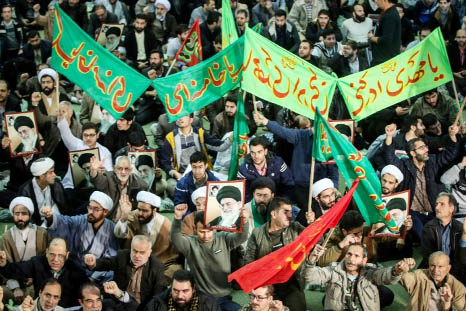
Four people died overnight in fresh unrest in Iran, local media reported on Monday, despite President Hassan Rouhani calling for calm and vowing more “space for criticism” in a bid to head off days of protest.
Two people were shot dead in the southwestern town of Izeh, a local lawmaker said, as videos on social media showed demonstrations hitting many areas across the country for a fourth night.
“People of Izeh, like some other cities, held a protest against economic problems and unfortunately it led to the killing of two people and injuries to some others,” Hedayatollah Khademi, the local MP, told the ILNA news agency, adding it was unclear who had fired the shots.
The state broadcaster said two others died in the small western town of Dorud when they were hit by a fire engine stolen by protesters, and ILNA reported a school for clergy and government buildings were torched in the northwestern town of Takestan.
Rouhani finally broke his silence on Sunday night about the protests that mark the biggest test for the regime since mass demonstrations in 2009.
“The people are absolutely free in expressing their criticisms and even protests,” Rouhani said in a message on the state broadcaster.
“But criticism is different to violence and destroying public property.”
Police used tear gas and water cannon to disperse a small protest in Tehran’s Enghelab Square on Sunday evening, according to unverified social media videos.
There were also reports of protests in the cities of Kermanshah, Khorramabad, Shahinshahr and Toyserkan in the west, and Zanjan in north Iran.
More than 400 people have been arrested in the four days of protest across Iran.
Verifying reports remained challenging due to travel restrictions and sporadic blocks on mobile internet and popular social media sites including Telegram and Instagram.
The protests began as demonstrations against economic conditions in second city Mashhad on Thursday but quickly turned against the Islamic regime as a whole, with thousands marching in towns across Iran to chants of “Death to the dictator”.
Rouhani sought a conciliatory tone, saying that government bodies “should provide space for legal criticism and protest” and calling for greater transparency and a more balanced media.
US President Donald Trump, a fierce critic of Tehran, said the “big protests” showed people “were getting wise as to how their money and wealth is being stolen and squandered on terrorism”.
He accused Iran of “numerous violations of human rights”, adding it “has now closed down the internet so that peaceful demonstrators cannot communicate. Not good!” Rouhani dismissed Trump’s comments.
“This man who today in America wants to sympathise with our people has forgotten that a few months ago he called the nation of Iran terrorist.”
After initial silence, state media began showing some footage of the demonstrations on Sunday, focusing on young men attacking banks and vehicles, an attack on a town hall in Tehran, and images of a man burning the Iranian flag.
“Those who damage public property, disrupt order and break the law must be responsible for their behaviour and pay the price,” Interior Minister Abdolrahman Rahmani Fazli said on Sunday.
There have been reminders of the continued support for the regime among conservative sections of society, with pro-regime students staging sizeable counterdemonstrations at the University of Tehran over the weekend.
Rouhani came to power in 2013 promising to mend the economy and ease social tensions, but high living costs and a 12 percent unemployment rate have left many feeling that progress is too slow.
“Rouhani has run an austerity budget since 2013 with the idea that it’s a tough but necessary pill to swallow to manage inflation and currency problems and try to improve Iran’s attractiveness for investment,” said Esfandyar Batmanghelidj, founder of the Europe-Iran Forum.
“But choosing years of austerity immediately after a very tough period of sanctions is bound to test people’s patience,” he told AFP.
Police have so far taken a relatively soft approach to the unrest.
The authorities have blamed external forces for fomenting violence, saying the majority of social media reports were emanating from regional rival Saudi Arabia or exile groups based in Europe.
Since the ruthless repression of the 2009 protests against a disputed presidential election that gave hardliner Mahmoud Ahmadinejad a second term, many middle-class Iranians have abandoned hope of securing change from the streets.
But low-level strikes and demonstrations have continued, with groups such as bus drivers, teachers and factory workers regularly protesting against unpaid wages and poor conditions.

